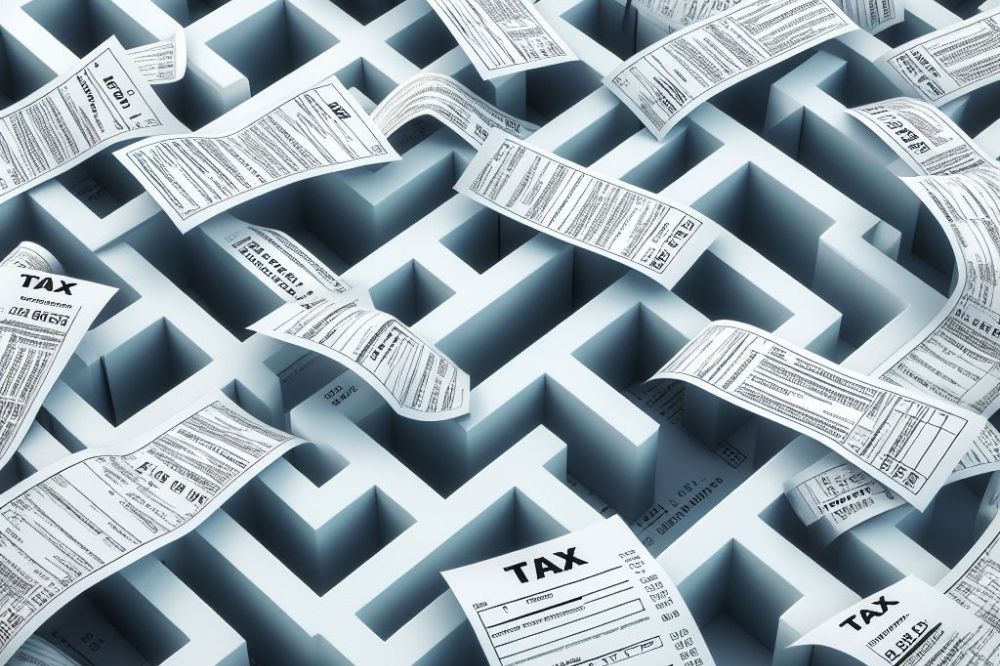Considering filing for bankruptcy due to overwhelming tax debt? Before taking that drastic step, research alternative solutions that may offer relief without the long-term consequences of bankruptcy. While bankruptcy can provide a fresh start, it comes with significant financial and credit implications, tax obligations, research, and an additional form. By contrast, negotiating an offer in compromise or setting up an installment plan with the IRS might be more manageable options. Understanding the nuances of each choice is crucial to make an informed decision that aligns with your financial goals and circumstances.
Key Takeaways
- Understand the implications of filing for bankruptcy as a response to tax debt, as it can offer relief but also has consequences.
- Prioritize knowing which tax debts are dischargeable through bankruptcy to make informed decisions.
- Be aware of how federal tax liens can impact your bankruptcy process and what steps can be taken to address them.
- Choose the optimal bankruptcy type based on your financial situation and goals, whether Chapter 7, Chapter 13, or another suitable option.
- Develop a bankruptcy strategy that considers your tax debt, assets, income, and long-term financial objectives for a successful outcome.
- Explore alternatives to bankruptcy such as an offer in compromise or installment agreement to resolve tax debt without filing for bankruptcy.
Bankruptcy Overview
Basics Explained
Bankruptcy is a legal process that helps individuals or businesses financially struggling to eliminate or repay debts. It provides relief by halting creditor actions and creating a repayment plan. Understanding bankruptcy implications is crucial for informed decision-making.
Tax Debt Role
Tax debt can significantly impact one’s financial stability, leading to severe consequences such as wage garnishment and asset seizure. Addressing tax debt promptly is essential to prevent escalating financial challenges and legal actions.
Bankruptcy Types
Different types of bankruptcy include Chapter 7 and Chapter 13. Chapter 7 allows individuals to discharge most debts quickly, while Chapter 13 involves creating a repayment plan over three to five years. Eligibility criteria vary, with Chapter 7 requiring a means test and Chapter 13 suitable for those with a regular income.
Tax Debt Dischargeability
General Conditions
When it comes to tax debt dischargeability, understanding the different tax types is crucial for making informed decisions. Federal and state taxes vary significantly in how they are treated in bankruptcy proceedings. Federal taxes typically have stricter regulations compared to state taxes.
In bankruptcy filings, the type of tax owed plays a significant role in determining the outcome. Federal taxes are usually more challenging to discharge than state taxes due to their stringent criteria. State taxes, on the other hand, may offer more flexibility in terms of dischargeability options.
Tax Type
- Federal and state taxes differ significantly in their treatment within bankruptcy proceedings.
- Federal tax debt is generally harder to discharge compared to state tax obligations.
- The type of tax owed can impact the feasibility of resolving debts through bankruptcy.
Filing Date
Adhering to specific filing deadlines is crucial when considering bankruptcy as a solution for tax debt relief. The timing of your filing can influence the overall success of your bankruptcy case. Choosing the right filing date is essential for maximizing the benefits of bankruptcy protection.
The filing date is a critical factor that can affect the outcome of your bankruptcy process. Being mindful of deadlines and selecting an optimal filing date can streamline the resolution of your tax debt issues. Tips for choosing an appropriate filing date can enhance your chances of a successful bankruptcy discharge.
Assessment Period
The assessment period refers to the timeframe during which tax liabilities are evaluated concerning bankruptcy proceedings. Understanding this period’s implications is vital for navigating debt resolution effectively. The assessment period directly impacts how tax debts are addressed within bankruptcy cases, shaping the overall outcome.
In the context of bankruptcy, the assessment period holds significant importance as it determines how tax debts are managed and resolved. A clear understanding of this period’s implications can help individuals make informed decisions regarding their financial obligations. Resolving tax debts hinges on successfully navigating through this critical assessment phase.
Specific Scenarios
Federal Taxes
Federal taxes pose unique challenges when seeking relief through bankruptcy proceedings. Understanding how federal taxes are treated and what options are available is key to effectively managing these obligations within a bankruptcy context. The implications of federal tax debt on bankruptcy outcomes should be carefully considered before proceeding with any filings.
- Treatment of federal taxes differs from other types of debts in bankruptcy.
- Options for addressing federal tax debt within a bankruptcy framework vary.
- Implications of federal tax obligations play a significant role in determining bankruptcy outcomes.
State Taxes
Handling state taxes in a bankruptcy case requires a nuanced approach distinct from dealing with federal taxes. Comparing and contrasting how state taxes are treated relative to federal obligations can provide insights into developing effective strategies for managing these debts through bankruptcy proceedings. Addressing state tax debt necessitates careful consideration due to its unique characteristics within a bankruptcy context.
- State tax treatment within bankruptcies differs from federal taxation procedures.
- Comparison between handling state vs. federal taxes illuminates distinct nuances.
- Managing state tax liabilities through bankruptcies requires tailored strategies for resolution.
Federal Tax Lien
Understanding Liens
Tax liens represent the government’s legal claim on your property due to unpaid taxes. These liens can significantly impact bankruptcy proceedings, complicating the process and affecting asset distribution. When filing for bankruptcy, addressing tax liens is crucial to resolving outstanding tax obligations. Strategies such as lien avoidance or lien stripping can help manage tax liens during bankruptcy, allowing for a smoother financial recovery.

Discharge Possibility
Discharging tax debt through bankruptcy is possible but subject to specific conditions. Tax debt can be discharged in Chapter 7 or Chapter 13 bankruptcy if it meets certain criteria, such as being income tax rather than payroll taxes. The likelihood of discharging tax debt depends on factors like the age of the debt and compliance with tax laws. Consulting with a bankruptcy attorney is essential to navigate the complexities of discharging tax debt successfully.
Lien vs. Debt
Tax liens and tax debt differ in their legal implications during bankruptcy proceedings. While tax debt refers to the actual amount owed to the IRS, a tax lien is a claim against your property to secure payment of that debt. In bankruptcy, tax liens survive the discharge of personal liability, meaning they continue to exist even after other debts are cleared. Handling tax liens versus tax debt requires different strategies, as each has distinct consequences for your financial future.
Optimal Bankruptcy Types
Chapter 7 Bankruptcy
Chapter 7 bankruptcy involves liquidating assets to pay off debts, providing a fresh financial start. Debts are discharged quickly, usually within a few months, offering relief from overwhelming obligations. Individuals with limited income and substantial debt can benefit from Chapter 7 bankruptcy.
Filing for Chapter 7 bankruptcy can lead to the elimination of unsecured debts like credit card balances and medical bills. There is no repayment plan, allowing for a quicker resolution compared to other bankruptcy types. To qualify for Chapter 7 bankruptcy, individuals must pass the means test by demonstrating insufficient disposable income.
Chapter 13 Bankruptcy
Chapter 13 bankruptcy entails creating a repayment plan to settle debts over three to five years. It allows individuals to retain their assets while restructuring their finances. Opting for Chapter 13 bankruptcy provides an opportunity to catch up on missed mortgage or car payments through the repayment plan.
The advantages of Chapter 13 bankruptcy include the ability to prevent foreclosure or repossession by restructuring debts. Individuals with regular income who do not meet the Chapter 7 eligibility requirements often opt for this type of bankruptcy. The repayment plan considers the individual’s income and expenses to determine monthly payments.
Comparing Benefits
When comparing Chapter 7 and Chapter 13 bankruptcies, it’s essential to consider individual financial situations. Chapter 7 is ideal for those with minimal assets and overwhelming unsecured debts seeking quick relief. In contrast, Chapter 13 suits individuals with regular income looking to protect assets while repaying debts gradually.
Chapter 7 offers a faster resolution and complete discharge of qualifying debts but may require surrendering non-exempt property. On the other hand, Chapter 13 allows individuals to keep their assets while adhering to a court-approved repayment plan. Choosing between them depends on factors like income, asset ownership, and debt amount.
Bankruptcy Strategy
Preparation Steps
When considering bankruptcy, start by outlining your financial situation clearly to understand the extent of debt. Gather all necessary documentation such as income statements, tax returns, and asset information. Organize your finances meticulously before proceeding with bankruptcy to ensure a smooth process.
List of essential steps for preparing bankruptcy:
- Assessing total debt
- Compiling financial documents
- Seeking professional advice if needed
Documentation required includes:
- Income statements
- Tax returns
- Asset information
Tips for organizing finances before filing bankruptcy:
- Create a detailed budget
- Prioritize essential expenses
- Explore debt repayment options before resorting to bankruptcy
Filing Process
To initiate the bankruptcy process, follow a step-by-step approach starting with determining the most suitable bankruptcy type based on your financial situation. Complete the necessary paperwork accurately and submit it within the specified timeline. Understanding and navigating through the filing procedures efficiently is crucial for a successful bankruptcy filing.
Key points in the filing process include:
- Choosing the appropriate bankruptcy type
- Filling out forms accurately
- Meeting deadlines for submission
Paperwork and forms required for a successful filing:
- Bankruptcy petition
- Schedules of assets and liabilities
- Proof of income
Insights into navigating bankruptcy filing procedures effectively:
- Seek legal guidance if unsure about any aspect of the process
- Keep track of deadlines and requirements diligently
Post-Bankruptcy Plan
After bankruptcy, creating a comprehensive post-bankruptcy financial plan is vital to regain financial stability. Rebuilding credit post-bankruptcy requires strategic actions such as obtaining secured credit cards or loans and making timely payments. Managing finances effectively after bankruptcy ensures long-term financial health.
Importance of creating a post-bankruptcy financial plan:
- Setting achievable financial goals
- Establishing a budget for expenses and savings
- Monitoring credit score regularly
Steps to rebuild credit after bankruptcy:
- Obtaining secured credit cards or loans
- Making timely payments
- Keeping credit utilization low
Tips for managing finances post-bankruptcy:
- Avoid taking on unnecessary debt
- Build an emergency fund for unexpected expenses
Alternatives to Bankruptcy
Payment Plans
Payment plans in bankruptcy involve structured schedules for repaying tax debts. Types include installment agreements and partial payment plans. Choosing a sustainable payment plan is crucial for long-term financial stability.
Offer in Compromise
An offer in compromise allows taxpayers to settle their tax liabilities for less than the full amount owed. Negotiating this involves proving financial hardship. Pursuing an offer in compromise can lead to reduced debt and potential relief from overwhelming tax burdens.
Currently Not Collectible
Currently not collectible status means the IRS acknowledges a taxpayer’s inability to pay tax debts currently. This status temporarily suspends collection activities, providing breathing room for financial recovery. However, being classified as currently not collectible does not erase the debt; it merely delays collection efforts.
Qualifying for Relief
Eligibility Criteria
To qualify for bankruptcy, individuals must meet certain criteria such as having mounting debts and minimal income. Specifically concerning tax debt, eligibility is determined by the type of taxes owed and when they were assessed. Factors like filing history and fraud also play a role in qualification.
The eligibility for bankruptcy can be impacted by various factors, including the types of debts involved and the individual’s financial situation. For tax-related bankruptcies, meeting specific conditions related to tax types and timing is crucial.
Assessment Process
The assessment process for bankruptcy involves a detailed review of an individual’s financial status, including assets, income, expenses, and debts. Financial assessments are critical in determining the most suitable bankruptcy option based on the individual’s financial standing.
When evaluating bankruptcy options, several criteria are considered, such as the amount of debt owed, income level, assets owned, and expenses incurred. These evaluation criteria help determine the most appropriate course of action for debt relief.

Professional Advice
Seeking professional advice before filing for bankruptcy is essential to navigate the complex legal processes involved. Bankruptcy attorneys and financial advisors play crucial roles in providing guidance on the best approach to address tax debt through bankruptcy.
Choosing the right professionals for bankruptcy guidance is vital for a successful outcome. Consider factors such as experience, expertise in tax-related bankruptcies, and client reviews when selecting attorneys or financial advisors for assistance.
Bottom Line Considerations
Pros and Cons
Filing for bankruptcy can provide immediate relief by halting creditor actions such as wage garnishment or lawsuits. It offers a fresh financial start.
However, bankruptcy may have long-term consequences, impacting credit scores and access to future loans. It’s crucial to weigh the pros and cons.
- Pros:
- Immediate relief from creditor actions
- Fresh start for financial stability
- Cons:
- Long-term impact on credit scores
- Limited access to future loans
Long-term Impact
Bankruptcy can have lasting effects on an individual’s financial health, influencing their ability to secure loans or mortgages in the future. It’s essential to consider the implications carefully.
Filing for bankruptcy can significantly lower credit scores, making it challenging to qualify for favorable interest rates or financing options. Planning ahead is key.
Making the Decision
When contemplating bankruptcy as a response to tax debt, it’s vital to seek professional advice from financial advisors or bankruptcy attorneys. They can provide valuable insights into the process.
Factors such as the amount of debt, income level, and assets should be evaluated before deciding on bankruptcy. Understanding the consequences is crucial in making an informed decision.
- Factors to consider:
- Amount of debt owed
- Income level and assets
- Potential long-term impact on financial health
Closing Thoughts
In navigating tax debt and bankruptcy, understanding dischargeability, federal tax liens, and optimal bankruptcy types is crucial. Crafting a strategic approach while considering alternatives and qualification criteria can significantly impact your financial future. Remember that each decision you make now shapes your path to financial stability.
As you explore the complexities of tax debt and bankruptcy, seek professional advice tailored to your unique situation. Your financial well-being is paramount, and informed choices today pave the way for a brighter tomorrow. Stay proactive, stay informed, and take the necessary steps towards a more secure financial future.
Frequently Asked Questions
What is the primary purpose of filing for bankruptcy in response to tax debt?
Filing for bankruptcy can provide relief from overwhelming tax debt by potentially discharging or restructuring the debt, halting collection actions, and offering a fresh financial start.
How can I determine if my tax debt is dischargeable through bankruptcy?
Tax debt dischargeability depends on factors like the type of taxes owed, when they were due, and whether you filed returns. Consult a tax professional or bankruptcy attorney to assess your specific situation.
Which types of bankruptcy are optimal for addressing tax debt issues?
Chapter 7 may discharge eligible tax debts entirely, while Chapter 13 can help restructure and repay tax debts over time. The best option depends on your financial circumstances and goals.
Are there alternatives to filing for bankruptcy to address tax debt?
Yes, alternatives such as negotiating with the IRS for an installment agreement, offer in compromise, or seeking innocent spouse relief may be viable options depending on your situation.
What are the key considerations for determining eligibility for relief when facing tax-related financial hardships?
Factors like the amount and type of tax debt, compliance with filing requirements, timing of assessments, and previous bankruptcy filings can impact your eligibility for relief options. Seek professional advice to evaluate your qualifications.




